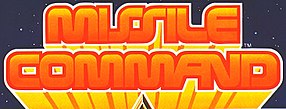Missile Command
| Missile Command | |
|---|---|
| Studio | Atari |
| Publisher | Atari |
| Senior Developer | Dave Theurer , Rob Fulop |
| Erstveröffent- lichung |
July 1980 |
| genre | Shoot 'em up |
| Game mode | Two players take turns |
| control | Trackball ; 3 buttons |
| casing | Standard, Mini, Cocktail and Cockpit |
| Arcade system | Main CPU : 6502 (@ 1 MHz) Sound CPU: Sound chips: Pokey (@ 1.25 MHz) |
| monitor | Raster resolution 256 × 231 (4: 3 horizontal) Color palette: 8 |
| information | Atari classics |

Missile Command is a classic computer game from the game manufacturer Atari , which was first released as an arcade game in 1980 . It has been ported to numerous systems since its inception .
Gameplay
The player has to protect six cities against nuclear missile impacts. At the bottom of the screen, in addition to the cities, there are also three defense batteries of the player (left, center and right). The enemy missiles appear as lines falling from the top of the screen onto the cities and launching bases. Often bombers or killer satellites appear in the stylized sky, which also drop missiles. Missiles can split up into individual warheads, which means that three or more projectiles instead of one must be hit.
Using a trackball , the player controls a crosshair across the screen. If he presses one of the three launch buttons, the corresponding battery fires a defense missile in the direction of the cross. After a short flight time, the defense missile explodes at the marked location, where it briefly creates a cloud of explosion. Enemy missiles, killer satellites or bombers that get into this cloud will be destroyed. The cloud is not permanent, so the missile must be fired at an appropriate time for the targeted targets to fly in.
Each defense battery only has ten defense missiles, so the defender can only fire 30 shots per level.
If an attack missile gets through and hits a city, it is destroyed. If a missile hits a defense base, all defense missiles in it are lost. At the end of the attack wave, surviving cities and unused defensive missiles are counted and result in bonus points. If no city has survived, the game is over. For every 10,000 points achieved, the player receives a bonus city.
There are more points in each level, but the attackers' speed also increases. Later on, so-called “smart missiles” were added, which can avoid the clouds of explosion from the defense missiles and can only be destroyed with a direct hit.
Like most arcade games, this game is not up for grabs. It's just a matter of holding out for as long as possible and collecting points.
background
The game was one of the most successful titles of the golden era of computer games. In the mid-1990s there were still numerous arcade machines with this title.
The game was originally called Armageddon . Later console games were inspired by Missile Command, according to Fantavision (PlayStation 2, 2000).
Missile Command in the movie
In a movie scene in Terminator 2 , John Connor plays the game "Missile Command".
In the television series Chuck , episode S02E05 is all about the game "Missile Command". When playing through (reaching 2,000,000 points) the so-called "kill screen" appears here with the code OZPGSB , which is required to deactivate a satellite. The mathematical basis of the gameplay is connected here with the song Tom Sawyer by the band Rush .
Ports
- Acorn Electron (1983)
- Atari 800 (1981)
- Atari 2600 (1981)
- Atari 5200 (1982)
- Atari Flashback II (2005)
- Atari Jaguar as Missile Command 3 D
- Atari ST (1986)
- Atari XEGS (1987) as a boot-up game if no cartridge is inserted when starting
- Atari Lynx (1994)
- BBC B (1983)
- Commodore 64 (1983)
- Game Boy / Game Boy Color / Game Boy Advance (1991/2002)
- Microsoft Xbox (2004)
- Microsoft Xbox 360
- Nintendo SNES (1997)
- Nintendo DS on Retro Atari Classics (2005)
- Nokia N-Gage on Atari Masterpieces Vol.1 (2005)
- PC Windows (first in 1993, last in 2003 on Atari - 80 Classic Games in One! )
- PlayStation 1/2 (2001/2004)
- Sega Dreamcast (2001)
- Sega Master System on Arcade Smash Hits (1992)
- Tandy TRS-80 Color Computer (1982)
- Vtech Laser-VZ
- Sinclair ZX Spectrum (1983)
- Smartphone
See also
Web links
- Missile Command in the Killer List of Videogames (English)
- Missile Command at MobyGames (English)
- Arcade history entry

